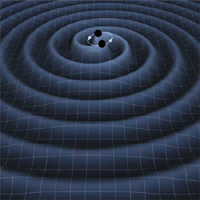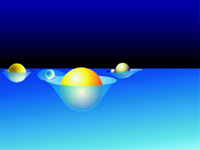 |
Artist's concept of gravitational waves. Courtesy of LISA.
|
Did you know that our oceans are not the only place in the Universe where waves exist? There are waves in space! And, they travel just like those that surge toward the many far shores on Earth's surface.
Ocean waves are created by large disturbances, such as storms or other atmospheric conditions. Similarly, disturbances in space cause gravitational waves. Scientists want to know more about these gravitational waves and their sources because they can us help us understand more about the cosmos. For, unlike electromagnetic light waves that eventually break up and scatter, scientists think that gravitational waves travel across the Universe undiminished. Therefore, the signals they carry will give us important information about ancient cosmic events. To aid scientists in their quest to detect and measure gravitational waves, the Space Technology 7 project will flight test a Disturbance Reduction System (DRS) that is planned for launch on the LISA Pathfinder mission in 2013. LISA Pathfinder is a mission of the European Space Agency (ESA). Space Technology 7 was initiated under NASA's New Millennium Program.
ST7's Disturbance Reduction System incorporates enhanced thruster technology, which works with enhanced sensor technology provided by ESA. Together, these technologies will demonstrate precision spacecraft control, validating position-measurement of objects in weightlessness with 100 times greater accuracy than ever before. In fact, during the ST7 test flight, the DRS is expected to achieve close to the ultimate in weightlessness.
 |
Artist's concept of Einstein's
theory of warped space.
Courtesy of LISA.
|
ST7's validated DRS will contribute to the success of future missions——formation-flying interferometer missions that require precise spacecraft-position control and missions to measure gravitational forces. One such mission is the joint ESA and NASA Laser Interferometer Space Antenna (LISA).
LISA will detect and measure passing gravitational waves and map the curvature of space-time. This curvature, an idea first proposed by Albert Einstein in 1915, is caused by the gravity of planetary bodies such as the Sun and Earth or by gravitational waves generated by the motions of supermassive objects such as extra-galactic (outside of our galaxy) black holes. As part of LISA, ST7's DRS technology will "ride" the gravitational waves, and enable scientists to conduct tests of Einstein's Theory of General Relativity.
Jet Propulsion Laboratory's Astronomy and Physics Directorate manages ST7's technology development, in partnership with Goddard Space Flight Center, and the Busek Company, Incorporated. The DRS will help create the ultimate still and quiet environment for science measurements. ST7's refined technology may lead to a whole new understanding of planetary and cosmic gravitational forces.